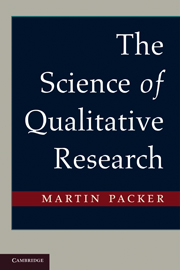Book contents
- Frontmatter
- Contents
- List of Figures and Tables
- List of Boxes
- Acknowledgments
- Introduction
- Part I The Objective Study Of Subjectivity
- 1 What Is Science?
- 2 The Qualitative Research Interview
- 3 The Analysis of Qualitative Interviews
- 4 Hermeneutics and the Project for a Human Science
- 5 Qualitative Analysis Reconsidered
- Part II Ethnographic Fieldwork – The Focus On Constitution
- Part III Inquiry With An Emancipatory Interest
- References
- Name Index
- Subject Index
3 - The Analysis of Qualitative Interviews
- Frontmatter
- Contents
- List of Figures and Tables
- List of Boxes
- Acknowledgments
- Introduction
- Part I The Objective Study Of Subjectivity
- 1 What Is Science?
- 2 The Qualitative Research Interview
- 3 The Analysis of Qualitative Interviews
- 4 Hermeneutics and the Project for a Human Science
- 5 Qualitative Analysis Reconsidered
- Part II Ethnographic Fieldwork – The Focus On Constitution
- Part III Inquiry With An Emancipatory Interest
- References
- Name Index
- Subject Index
Summary
Coding is analysis.
Miles & Huberman, 1984, p. 56The declared aim of modern science is to establish a strictly detached, objective knowledge. Any falling short of this ideal is accepted only as a temporary imperfection, which we must aim at eliminating. But suppose that tacit thought forms an indispensable part of all knowledge; then the ideal of eliminating all personal elements of knowledge would, in effect, aim at the destruction of all knowledge. The ideal of exact science would turn out to be fundamentally misleading and possibly a source of devastating fallacies.
Polanyi, 1967, p. 20In the standard qualitative research project, the step after conducting an interview is to transcribe it and analyze the material obtained. The analysis of qualitative material causes much anxiety and confusion for researchers, especially students conducting research for the first time. Yet remarkably little is said about analysis in many introductory qualitative research textbooks, and what is said is often unclear.
For example, Seidman’s (1998) comprehensive book Interviewing as Qualitative Research includes only 14 or so pages on the topic of analysis out of a total of 124. Maxwell, in an otherwise excellent book titled Qualitative Research Design, writes in the chapter titled “Methods: What Will You Actually Do?” that his discussion “is not intended to explain how to do qualitative data analysis” (Maxwell, 2005, p. 95, emphasis original). This is odd coming from someone who offers an “integrative approach” to qualitative research design and insists, surely correctly, that all the elements of project design should interrelate. Maxwell talks only in general terms about analytic strategies of “categorizing” and “connecting,” and it is not clear how these link to the research questions that orient a study or to the other components – goals of the study, theoretical framework, and others – whose interconnections he considers carefully.
- Type
- Chapter
- Information
- The Science of Qualitative Research , pp. 57 - 81Publisher: Cambridge University PressPrint publication year: 2010



